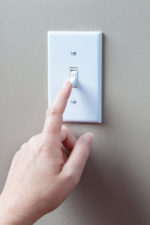How to Master Contemporary Style
Contemporary homes are often at the forefront of revered interior design, and for good reason: they’re elegant, refined, and thoughtfully curated.
This style is the stuff of impressive home decor publications and top design studios alike. If contemporary features speak to you, learn about its central principles to inspire your decorative choices.

What is contemporary design?
This style doesn’t necessarily have a distinct look, as rustic and traditional styles do. In fact, contemporary design is changing all the time. As design reviewer Lauren Oster of HGTV.com notes, homes of this style are “able to adapt on the fly to incorporate emerging trends in the design world.” In that sense, saying that you want to imitate contemporary design is like saying you want to wear a fashionable outfit; it means something different today than it did a few years ago.
It’s this commitment to evolving design that actually makes contemporary style what it is. At the same time, some key principles will always remain true for it. No matter what specific trends come and go, the following pillars of contemporary style should persist.
Architecture forward
Contemporary design doesn’t intend to conceal your walls, floors, or windows. Rather, this style promotes ornamenting the architecture that makes your home distinct. Design every room with practical considerations like breezy foot traffic in mind, and orient furniture around architectural focal points such as large windows, an archway, or a fireplace. Try to identify at least one feature in each room that you enjoy, even if it’s just a window. Then highlight that feature and make it sing by framing it with decor like long drapes and a cushioned bench.

Color conscious
To create a contemporary home, use color wisely. Design a simple color palette around neutral shades like white and gray, and pepper in warm or cool colors for balance. For instance, if your living room’s tan walls are dominating the space, toss in features of a contrasting color like navy blue to help the different visual elements pop. Compatible colors make for interesting design, but you should only implement about five individual colors at most to avoid clashing.
Contrasting yet compatible
The most impressive contemporary interiors balance not only dark and like colors but also other opposites like old and new. When designing your home, blend furniture and decor that represent current trends with timeless antiques of quality construction. The traditional features will give your space a rich, vintage feel while the modern ones will keep it fresh.
Similarly, contemporary design varies textures and materials to help catch the eye. If you’re looking to make style updates, consider which materials are unrepresented. For example, a dining room with a wooden table could benefit from the contrast of a metal light fixture and soft upholstered chairs, while a living room dominated by plush fabric furniture would look pleasant around a stone cocktail table. If something still feels off, continue playing around with your decor until you achieve the balanced, intriguing look you’re after.

Ahead of the curve
Contemporary interiors don’t commit to a specific era in time, so, as time passes, trending decor will cycle to keep up. Make ongoing swaps to keep your home fresh, and check out design stores and publications often to keep up to date with top names for gorgeous home goods such as Hans J. Wegner (chairs), Maharam (fabrics), and Andromeda (light fixtures). As for impressive statement decor, refer to publications like Artforum and Artnet to explore trending fine art. You don’t have to invest in furniture or decor by specific names, but imitating what’s currently in style can all but guarantee your home will feel contemporary and elegant.


















